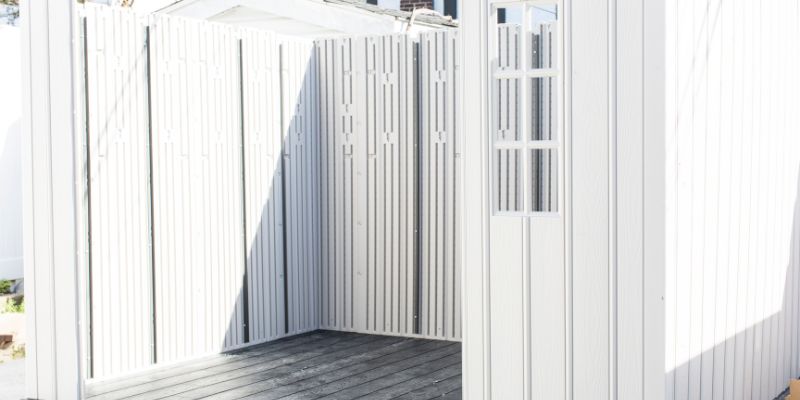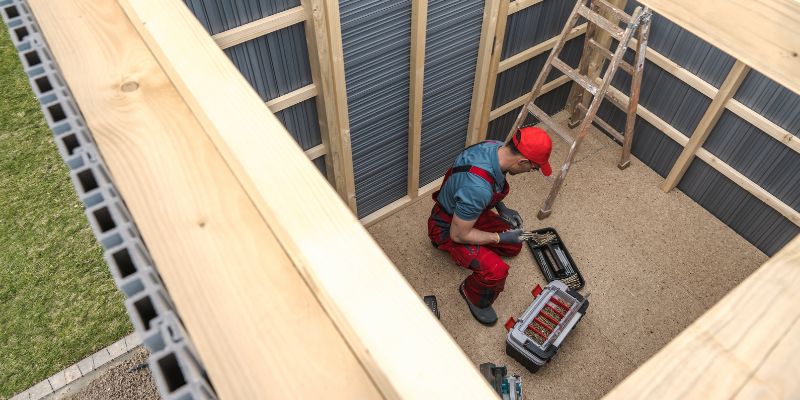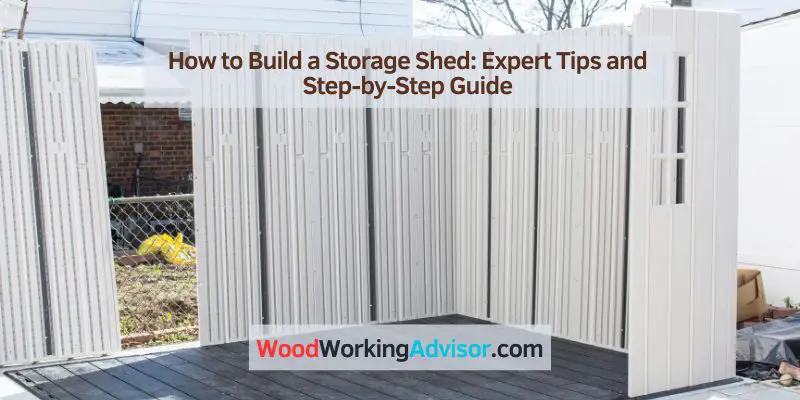Building a storage shed requires careful planning and preparation. Begin by determining the shed’s size and location, obtaining necessary permits, and gathering all the required materials and tools.
A storage shed provides a convenient solution for storing items such as gardening tools, lawn equipment, and seasonal items. Whether you need extra storage for your outdoor gear, or a dedicated space for your hobbies, a well-built storage shed can be a valuable addition to your property.
From selecting the right design and materials to proper construction and finishing, this guide will outline the essential steps to build your own storage shed. With the right approach and attention to detail, you can create a durable and functional storage space that meets your specific needs.
Planning Your Storage Shed
Planning is a crucial phase when building a storage shed. This is the stage where you make important decisions that will lay the foundation for the successful construction of your shed. From understanding local regulations and permits to choosing the right location, size, materials, and design considerations, meticulous planning ensures a functional and aesthetically pleasing storage shed that meets both your needs and regulatory requirements.
Understanding Local Regulations And Permits
Before embarking on your storage shed project, it’s essential to familiarize yourself with the local regulations and obtain the necessary permits. Building codes, zoning ordinances, and property setbacks can dictate the size, location, and design of your shed. Compliance with these regulations not only ensures legal adherence but also contributes to a harmonious neighborhood environment.
Choosing The Right Location And Size For Your Shed
The location and size of your storage shed are pivotal in its functionality and visual appeal. Consider the proximity to your house, accessibility, and the impact on your property’s aesthetics. Additionally, ensure that the size of the shed meets your storage needs without overpowering the available space. A well-planned location and size will seamlessly integrate your shed into your property.
Selecting Materials Based On Climate And Durability
Climate and durability are key factors when selecting materials for your storage shed. Choose materials that can withstand the local climate, whether it’s extreme heat, cold, or moisture. Opt for durable materials that require minimal maintenance, such as pressure-treated lumber, metal, or vinyl. Your material selection should align with the longevity and resilience you desire for your storage shed.
Design Considerations For Functionality And Aesthetics
Designing your storage shed involves considering both functionality and aesthetics. Determine the interior layout for efficient storage and easy access to your items. The exterior design should complement your home’s architecture while enhancing the overall visual appeal of your property. By marrying functionality and aesthetics, you can create a storage shed that is both practical and visually pleasing.

Incorporating ‘how To Build A Storage Shed’ Into Your Backyard Landscape
When adding a storage shed to your backyard, it’s crucial to seamlessly integrate it into your existing landscape for both functionality and aesthetic appeal. By carefully considering the style, color, and surrounding landscaping, you can ensure that your new storage shed becomes an attractive and cohesive part of your outdoor space.
Integrating Your Shed With Existing Outdoor Features
Before beginning construction, take stock of the existing outdoor features in your backyard. Consider the placement of trees, gardens, and any other structures. Aim to position your storage shed in a way that complements these elements and creates a harmonious flow within your landscape.
Deciding On The Style And Color To Complement Your Home
Choose a style and color for your storage shed that harmonizes with the architectural style and color palette of your home. This will help the shed blend seamlessly into your backyard landscape, enhancing the overall visual appeal of your property. Consider using a similar color or complementary hues to unify the space.
Landscaping Ideas To Blend The Shed Into Your Yard
Once the shed is in place, consider landscaping around it to seamlessly integrate it into your yard. Planting shrubs or flowers around the base of the shed can soften its appearance and create a natural transition between the structure and the surrounding landscape. Additionally, incorporating a well-defined pathway leading to the shed can further enhance its integration into your backyard.
Laying A Solid Foundation
Building a storage shed is an excellent way to add functional space to your property, and laying a solid foundation is crucial to ensure the structure’s longevity and stability. A well-constructed foundation will support the shed and protect it from moisture, ensuring its durability. In this guide, we will discuss the importance of evaluating different types of shed foundations, walk through a step-by-step guide on preparing the ground, and emphasize the significance of ensuring level and stability for longevity.
Evaluating Different Types Of Shed Foundations
Before beginning the construction of a storage shed, it’s essential to evaluate different types of shed foundations to determine the most suitable option for your specific needs. Common foundation types include concrete slabs, gravel pads, and treated wood skids. Each type has its advantages and considerations, such as cost, permanence, and the level of site preparation required.
Step-by-step Guide On Preparing The Ground
Preparing the ground for a shed foundation involves several essential steps. Firstly, the area should be cleared of any debris, rocks, and vegetation. Next, the ground needs to be leveled to ensure a uniform base for the foundation. Depending on the chosen foundation type, additional steps such as compacting the soil or creating forms for concrete may be necessary.
Ensuring Level And Stability For Longevity
Once the foundation is in place, it’s crucial to ensure that it is level and stable to support the weight of the shed and withstand environmental factors. This may involve using a level and shims to make precise adjustments, or adding bracing and anchors to enhance stability. Taking the time to ensure the foundation’s level and stability will contribute to the overall longevity and performance of the storage shed.
Expert Tips For Constructing The Frame
When it comes to building a storage shed, constructing the frame is a critical step that requires precision and expertise. The frame provides the structural support for the entire shed, so it’s important to get it right. In this section, we’ll cover the essential tools and materials you’ll need for frame construction, techniques for building walls, roof, and door frames, as well as important safety precautions to ensure a smooth and secure construction process.
Tools And Materials Checklist For Frame Construction
Before diving into the construction of the frame, it’s essential to have the right tools and materials on hand. Here’s a checklist of the items you’ll need:
- Hammer
- Nails/screws
- Level
- Tape measure
- Saw
- Framing square
- Pressure-treated lumber for the frame
- Plywood or OSB sheathing for walls and roof
- Wood glue
Techniques For Constructing Walls, Roof, And Door Frames
Once you have gathered your tools and materials, it’s time to focus on the construction techniques for various frame components:
- Walls: Start by framing the walls on the shed floor. Use the framing square and level to ensure the walls are plumb and square. Remember to leave openings for windows and doors.
- Roof: Construct the roof frame using the appropriate pitch for your shed design. Ensure the rafters are evenly spaced and securely fastened to the walls.
- Door Frames: Carefully measure and cut the lumber for the door frame, ensuring it fits securely within the wall framework. Install hinges and latches for a functional door.
Safety Precautions During The Construction Process
During the construction of the frame, safety should always be a top priority. Here are some crucial safety precautions to keep in mind:
- Wear appropriate safety gear, including gloves and eye protection, when working with power tools.
- Ensure the work area is well-ventilated, especially when using adhesives or paints.
- Use caution when working at heights and always secure ladders and scaffolding properly.
- Keep the work area clean and free of debris to prevent tripping hazards.
Adding Walls And Roofing
As you continue with the construction of your storage shed, the next crucial steps involve adding walls and roofing. This is where the structure really starts to take shape, providing protection for your belongings from the elements. Here are the important considerations for this stage of the project:
Installing Siding: Wood, Metal, Or Vinyl Options
When it comes to siding options for your storage shed, you have several material choices to consider. Each option offers different benefits in terms of aesthetics, durability, and maintenance:
- Wood Siding: Provides a natural, rustic look. Requires regular maintenance such as painting and sealing to protect against rot and pests.
- Metal Siding: Offers durability and is relatively low-maintenance. However, it may be prone to rust over time if not properly treated and maintained.
- Vinyl Siding: Known for its low maintenance and variety of color options. It is resistant to rot, pests, and requires minimal upkeep. However, it may not offer the same aesthetic appeal as wood siding.
Choosing And Fitting The Right Roofing Material
Roofing your storage shed is a critical step in ensuring it remains watertight and protects the contents inside. Consider the following factors when selecting and fitting the roofing material:
- Material Selection: Various options such as asphalt shingles, metal roofing, or even polycarbonate panels are available based on your budget, climate, and aesthetics.
- Proper Fitting: Ensure that the roofing material is installed correctly to prevent leaks and ensure long-term durability. Seek professional assistance if necessary to guarantee a secure and weather-resistant roof.
Tips For Insulation And Weatherproofing Your Shed
Insulating and weatherproofing your storage shed is essential for maintaining a comfortable interior environment and protecting your belongings from harsh weather conditions. Consider the following tips:
- Insulation: Choose appropriate insulation materials based on your regional climate to maintain a comfortable temperature inside the shed. Options may include fiberglass, foam board, or spray foam insulation.
- Weatherproofing: Seal any gaps, cracks, or joints to prevent water infiltration using caulking, weather-stripping, and appropriate sealants for doors and windows. This will help to maintain a dry and secure interior space.

Finishing Touches For Your Storage Shed
When it comes to building a storage shed, the finishing touches are what truly bring the project together. From the flooring to the doors, windows, and hardware, as well as the painting and decorating, every detail contributes to the functionality and aesthetics of your shed. Let’s explore the essential finishing touches that will transform your storage shed into a practical and visually appealing space.
Options For Flooring: Concrete, Wood, Or Other Materials
Choosing the right flooring for your storage shed is crucial for durability and functionality. Here are some popular options to consider:
- Concrete: Ideal for heavy-duty use and offers a solid, low-maintenance surface.
- Wood: Provides a classic look and can be easily customized, but may require more maintenance.
- Other materials: Consider alternatives such as rubber tiles, vinyl, or composite materials, depending on your preferences and budget.
Recommendations For Doors, Windows, And Hardware
When it comes to the entry points and hardware for your storage shed, prioritize security, functionality, and aesthetics:
- Doors: Choose sturdy, weather-resistant doors with secure locks to protect your belongings.
- Windows: Consider adding windows to bring natural light into the shed but ensure they are equipped with durable, weatherproof frames and locks.
- Hardware: Opt for high-quality hinges, handles, and latches to ensure smooth operation and long-term reliability.
Painting And Decorating To Protect And Personalize Your Shed
To safeguard your storage shed from the elements and infuse your personal style, consider the following:
- Priming and painting: Use weather-resistant primer and paint to protect the shed from moisture, UV rays, and other environmental factors.
- Decorative touches: Add finishing touches such as trims, shutters, and potted plants to enhance the visual appeal and blend the shed with its surroundings.
Frequently Asked Questions For How To Build A Storage Shed
Is It Cheaper To Build Your Own Storage Shed?
It can be cheaper to build your own storage shed, especially if you have the skills and time. Hiring a professional can cost more. However, consider factors like materials, tools, and your expertise before deciding.
How Much Does It Cost To Build A 12×12 Shed Yourself?
Building a 12×12 shed yourself may cost around $500 to $3000, depending on materials and design.
What Is The Cheapest Shed To Build?
The cheapest shed to build is typically a small, simple design using basic materials. A lean-to or gable shed can be cost-effective options. Keep the size modest and opt for materials like wood or metal to minimize expenses. Consider pre-built kits for an affordable and convenient solution.
How Much Does It Cost To Build A 10×10 Storage Shed?
The cost to build a 10×10 storage shed varies, but generally ranges from $500 to $3500. Factors like materials, labor, and location influence the total cost. For a more accurate estimate, consult with local contractors or use online cost calculators.
Conclusion
Building a storage shed is a practical and rewarding project that adds value to your property. By following the steps provided, you can customize a storage solution that meets your specific needs. Remember to plan, gather materials, and take your time to create a durable and functional shed.
With the right tools and techniques, you’ll have a new storage space to enjoy for years to come.


